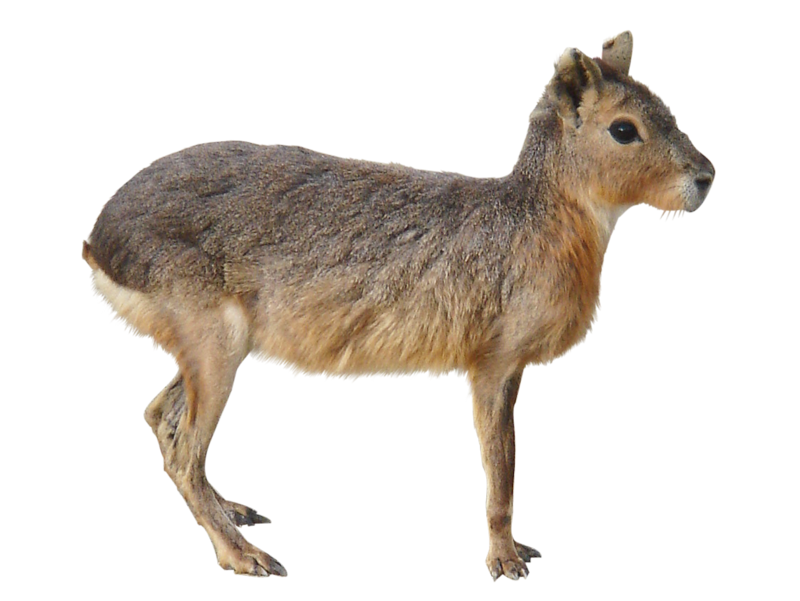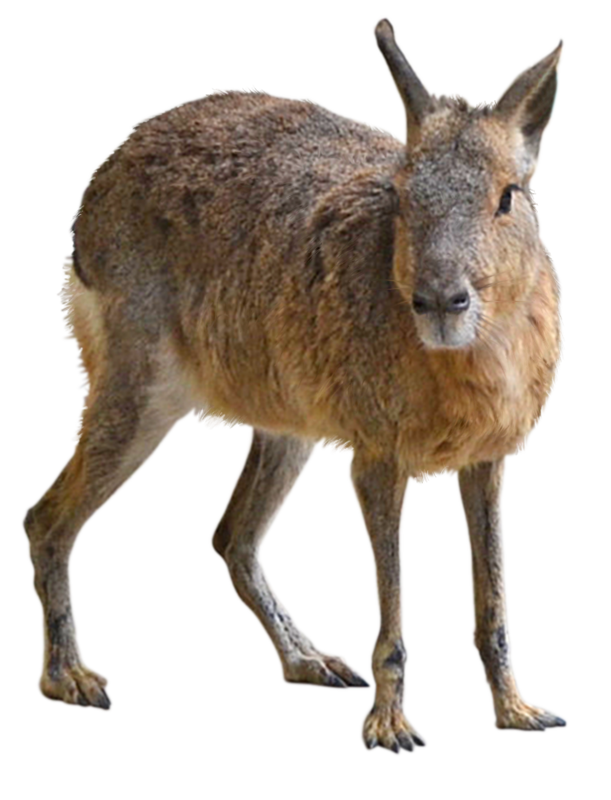Dolichotis patagonum (Zimmermann, 1780)
パタゴニアの草原を駆けるマーラ
The Mara of the Patagonian Grasslands
パタゴニアマーラは、南アメリカ南部のパタゴニア地方の草原に生息するテンジクネズミ科の大型のげっ歯類です。体長は60〜73センチ、尾の長さは約4センチ、体重は9〜16キログラムに達します。四肢は細く長く、短い尾は毛に覆われていません。大きな耳をもち、見た目はウサギに似ていますが、実際にはネズミの仲間であり、モルモットに近い種類とされています。開けた地形で素早く走ることができ、時速60キロに達することもあります。
哺乳類としては珍しく、一夫一妻制の生活を送り、ペアは長期間にわたって行動を共にします。メスはオスよりも採食に多くの時間を費やし、オスは一日の大部分を座って捕食者の見張りをする役割を担います。両親は共同の巣穴で子どもを育て、つがいの協力関係が群れの安定に寄与しています。
近年の研究(Antún et al., 2019)によると、マーラの生息密度は人間活動の程度によって大きく影響を受けることがわかっています。従来は人の進出が生息数を減少させると考えられてきましたが、実際には道路や牧場など中程度の人為的環境に近い地域ほど個体数が多いことが示されました。これは、放牧によって草が短く保たれ、捕食者が人を避けるため、マーラにとって安全で餌の豊富な環境が形成されるためと考えられています。一方で、過度な開発や都市化は依然として大きな脅威であり、IUCNでは準危急種(Near Threatened)に分類されています。
The Patagonian mara is a large rodent of the family Caviidae that inhabits the grasslands of Patagonia in southern South America. Its body length ranges from 60 to 73 cm, with a tail length of about 4 cm, and it weighs between 9 and 16 kilograms. It has long, slender limbs and a short, nearly hairless tail. With its large ears, it resembles a hare, but it actually belongs to the rodent family and is closely related to the guinea pig. It can run swiftly across open terrain, reaching speeds of up to 60 km/h.
Unusually for mammals, maras are monogamous, and pairs remain together for long periods. Females spend more time feeding than males, while males spend most of the day sitting and keeping watch for predators. Both parents raise their young in shared burrows, and this cooperative bond between mates contributes to the stability of their social groups.
A recent study (Antún et al., 2019) revealed that mara population density is strongly affected by the level of human activity. Contrary to the common assumption that human expansion reduces their numbers, the study found that maras are more abundant in areas with moderate human presence, such as near roads and grazing lands. This may be because livestock grazing keeps grasses short and predators tend to avoid human areas, creating a safe and food-rich habitat for maras. However, excessive development and urbanization remain major threats, and the species is classified as Near Threatened by the IUCN.
参考文献
野生の王国 群馬サファリパーク | 動物紹介 | マーラ 2024年6月8日閲覧
富士サファリパーク | 動物紹介 | マーラ 2024年6月8日閲覧
Antún, M., et al. “Modeling the spatial structure of the endemic mara (Dolichotis patagonum).” PeerJ, 2019. 2025年10月19日閲覧

